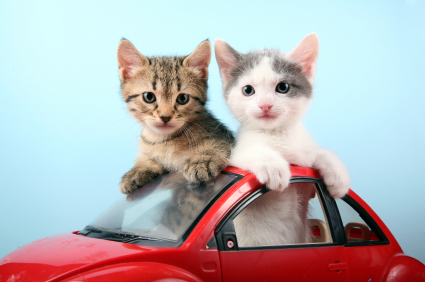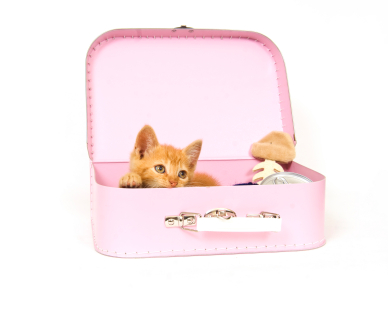Traveling with Your Cat

If you’re like most cat lovers, the first thing you think of when planning a trip or vacation is “what about my cat?” Leaving Fluffy home alone doesn't seem quite right. But a bad experience in the car or on a plane can make you both homesick in a hurry. Read on to learn the rules of the road.
Cats on the Go
If you’ve decided to take your cat along, start by making sure your feline friend has proper identification, should he stray or get lost. This means a collar with an ID Tag. Bring along a current photo of your pet should you need to create a "lost" poster. Your next step should be to schedule a visit to the veterinarian. This will ensure your cat is in good enough health to travel and is current on all necessary vaccinations. This is a good time to get an up to date copy of your pet's health records to bring along on your trip. Health records will be required should your pet become ill and have to visit a veterinarian while away from home. These records are also mandatory should you find you must board your pet for some unexpected reason during your travels. Then it’s time to decide how you and your cat are going to get there.
Taking Your Cat on a Plane
Air Travel has become more complex and stressful over the past decade, and not just for humans. Plan well ahead and be prepared to do a good deal of research and comparison shopping before you book a flight for you and your cat. Rules, restrictions and fees can vary dramatically depending on carrier, destination, and time of year.
There are two basic options for the feline passenger: cabin or cargo. Pets weighing fifteen pounds or less (including carrier) can usually go in the cabin, and most cats can squeeze into this category. The carrier, with kitty inside, must be able to fit under the seat in front of you. Your cat must stay inside the carrier for the duration of the flight. And don’t try sneaking any extra stowaways, because airlines allow only one cat per passenger. Finally, spots for pets in the cabin are subject to limited availability. You’ll want to confirm that there’s room for your cat on the flight before you commit.
If your cat or cats fail to meet these restrictions, they’ll have to be checked along with baggage into the pressurized cargo hold. Restrictions apply here too, so check with your individual airline.
Here are some questions to consider before you book the flight:
- At what time of year are you traveling? Federal, state, and airline-based regulations prohibit travel through destinations with where extreme temperatures may be in place. Animals are prohibited from traveling in cargo if weather conditions on the ground are either too cold (45 degrees Fahrenheit or below) or too hot (typically around 85 degrees Fahrenheit or above) at any stop along the way. Direct, nonstop flights are always advisable when traveling with your cat to avoid exposure to heat or cold during layovers.
- What documentation is required? Most airlines require a valid health certificate from your veterinarian. Domestic travel is usually fairly simple, although some states do have special vaccination requirements so it’s a good idea to check with the State Veterinarian at your destination. The rules for international travel are more complex. At minimum, a USDA health certificate is required. This goes along with whatever documentation, permit, or notarization is required by the country to which you’re traveling. For a comprehensive and up-to-date summary of rules and regulations for international travel, visit the USDA Animal and Plant Heath Inspection Service (APHIS) website . The importation process can take upwards of six months for heavily restricted countries, such as the United Kingdom, Hawaii, Australia and New Zealand so it’s essential to plan well ahead.
- Is your cat at risk for any health complications? Cats with frail health, or with respiratory or heart conditions may not handle stress well.
- Is your cat's carrier suitable? Federal guidelines dictate the size, strength, ventilation, labeling and sanitary provisions for pet carriers and kennels in cargo. Steer clear of cheap carriers that could open or break in transit. A soft-sided carrier is a nice option for a cat that will travel in the cabin with you, as long as it is secure. It’s best to check with the individual airline for specific requirements.
- Is your cat’s temperament suitable for air travel? Cats who meow incessantly, drool, vomit, soil, or try to claw their way out of the carrier are obviously not the best candidates for the friendly skies. Cats traveling in the cabin must be able to tolerate being taken in and out of the carrier for inspection when going through security. If your cat will be going on board with you, it is highly recommended that he or she wear a snug-fitting kitty harness and leash in case she tries to make a run for it.
If this all sounds too complicated, there’s a new option. Pet Airways runs charted flights for pets only, aboard private jets with pet-friendly amenities, departing from a growing list of major U.S. airports.
Traveling with Your Cat by Car
Let’s face it. Going by car be a lot less stressful and cheaper than flying for all concerned. If you’re not sure how your cat will do, taking him for a test drive around the neighborhood might give some indication.
For everyone’s safety, cats should always be inside a secure carrier in the back seat when  traveling in the car, not roaming free or in your lap. This reduces the risk that your cat will distract you while driving, or worse, be injured if the vehicle stops short or is involved in an accident. To make sure that kitty is not feeling stressed it may be a good idea to have someone sitting near the carrier to comfort her and have her bed or a recently worn shirt inside of the carrier to help create the comforts of home.
traveling in the car, not roaming free or in your lap. This reduces the risk that your cat will distract you while driving, or worse, be injured if the vehicle stops short or is involved in an accident. To make sure that kitty is not feeling stressed it may be a good idea to have someone sitting near the carrier to comfort her and have her bed or a recently worn shirt inside of the carrier to help create the comforts of home.
To help calm your kitty, spray Feliway spray in the carrier before putting her in it. It’s also a good idea to cover the carrier, while some cats may enjoy the view others might feel overwhelmed. Along the way, see if kitty’s preferences change. Never leave your cat alone in the car, even in the shade, even for a moment. Unattended cars can dangerously overheat in a surprisingly short period of time.
As for food and water, resist the temptation to put them in the carrier with your cat. They are likely to spill and make a mess. Your cat may not feel like eating or drinking in strange surroundings anyway. Better to offer her something to eat and drink at the end of the trip once you both settle in. Of course, this only applies if your cat is an adult and in good health. If your cat is very young or very old, diabetic or in kidney failure, or is generally frail, seek veterinary advice before taking your trip.
Don’t forget to pack the necessities (see box), including your cat’s own food, treats, and possibly water from home as a safeguard against tummy troubles. If you’ll be on the road for a while, check out PetFriendlyTravel.com, for pet-friendly restaurants, activities and lodging. And if it’s a big move, you may want to leave it to the professionals. Visit PetMovers.com. And since emergencies can happen, even away from home, don’t forget a kitty first aid kit.
There’s No Place Like Home for Your Cat
If a “stay-cation” is more up your cat’s alley, there are three main options: boarding, in-home care, or family and friends. As a general rule, cats are strongly attached to their own turf and their own routine. They prefer staying at home. This means enlisting a pet-sitter or trusted friend to care for, play with and feed your feline. If this isn’t possible, or if your cat has special medical needs, boarding is the option.
Your veterinarian knows your cat’s health and temperament and may be able to assist you with recommendations. The following are some online resources for finding suitable professional care for your cat while you’re away:
National Association of Professional Pet SittersPetsitters International
Sitter City
Boarding Kennels—Pet Care Services Organization
Travel can stress your cat out. Here are some common considerations:
- Allow kitty time to decompress and to become acquainted with the new surroundings.
- Set up kitties essentials like the litter box, food, water, toys.
- Try spraying Feliway around the designated "kitty areas" to help your cat feel more comfortable.
- Spend quiet time with kitty talking to her in a calm unstressed voice, to help establish normalcy.
- Motion sickness. Cats on the go can suffer motion sickness just like people. It’s best to avoid large meals, and even consider withholding food for several hours before travel. For cats that naturally have uneasy stomachs, there may be special medication that can help. Consult with your veterinarian.
- Travel anxiety. If your cat starts to pace, scratch, drool and meow the minute your car picks up speed, he may be suffering from a bona fide anxiety problem. Desensitization—pretend car trips that start very short and gradually increase, coupled with treats, praise and snuggles when your cat stays calm—can be effective. Your vet or veterinary behaviorist may have similar strategies to suggest.
- Tranquilizers. If your cat is likely to suffer severe distress, your veterinarian may be able to prescribe medication that will help. Tranquilizers or sedatives are not safe for air travel if your cat is going in cargo. These drugs can lower blood pressure, and slow heart and respiratory function, and no one will be there to assist if your cat has a bad reaction. Never give any medication to your pet except under the direction of your veterinarian.
- Natural remedies. Bach Flower Rescue Remedy added to your cat’s water can ease stress, as can Feliway spray sprayed in the area (Feliway is not for drinking water). Feliway mimics the “feel-good” pheromone that your cat deposits on you when she affectionately rubs up against you. It can be very effective in calming cats with general anxiety issues, which may include travel anxiety.
Once you know your feline friend is safe and comfortable, you can sit back and enjoy the ride.
You May Also Like These Articles:
Essentials for Your Feline First Aid Kit
Feliway - A Useful Tool to Help Treat Stress in Cats
Training Your Cat To Use A Pet Carrier
Reduce Pet Scratching Damage While Traveling
Notice: Ask-a-Vet is an affiliated service for those who wish to speak with a veterinary professional about their pet's specific condition. Initially, a bot will ask questions to determine the general nature of your concern. Then, you will be transferred to a human. There is a charge for the service if you choose to connect to a veterinarian. Ask-a-Vet is not manned by the staff or owners of CatHealth.com, and the advice given should not delay or replace a visit to your veterinarian.





